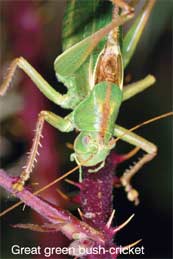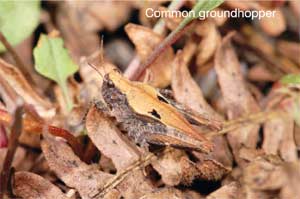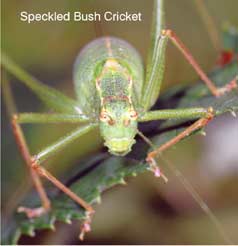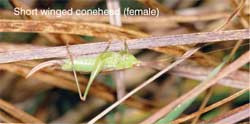Grasshoppers and Crickets - Healthy Life Essex
Home » Articles » Outdoor Life » Wildlife » Insects and Invertebrates » Grasshoppers and Crickets
Grasshoppers and Bush-Crickets in Essex
With the summer ahead we are given to thinking of those things that make the season. The spring has had its own. That sense of resurgence embodied by the carpets of woodland flowers, the branches above that resounded with birdsong and the hum of insect life that returned to the countryside. But what of the season that follows and the quintessential qualities of those long days and balmy nights?
There are many summery delights that could provide an answer, but there will be those who find the buzz and chirp of grasshoppers and bush-crickets the perfect aural accompaniment to the heat of high summer, with the incessant wall of sound generated by their ‘songs’ filling the grassland scene and wrapping itself around you as much as the blazing heat of the sunshine.
 The Orthoptera (the order of insects that includes grasshoppers, bush-crickets, true crickets and groundhoppers) are a fascinating group of insects, whose charms are perhaps somewhat overshadowed by such more celebrated invertebrates as the butterflies and dragonflies. Up close and personal the humble grasshopper and its kin are transformed into bizarrely beautiful creatures, all big eyes, armour plates and of course those great long, jumping legs. Bush-crickets in particular look splendidly outlandish, with bulky arched bodies, long antennae and legs so gangly as to look positively cumbersome, but which are in fact surprisingly adept at clambering among the vegetation. A female bush-cricket will brandish a fearsome looking sabre-like appendage on the tip of her abdomen, something that is employed no more aggressively than for inserting eggs into the stems of plants.
The Orthoptera (the order of insects that includes grasshoppers, bush-crickets, true crickets and groundhoppers) are a fascinating group of insects, whose charms are perhaps somewhat overshadowed by such more celebrated invertebrates as the butterflies and dragonflies. Up close and personal the humble grasshopper and its kin are transformed into bizarrely beautiful creatures, all big eyes, armour plates and of course those great long, jumping legs. Bush-crickets in particular look splendidly outlandish, with bulky arched bodies, long antennae and legs so gangly as to look positively cumbersome, but which are in fact surprisingly adept at clambering among the vegetation. A female bush-cricket will brandish a fearsome looking sabre-like appendage on the tip of her abdomen, something that is employed no more aggressively than for inserting eggs into the stems of plants.
 They do not, of course, actually sing, although each species does have its own ‘voice’, as distinctive as the calls of different birds. Their methods of singing, or stridulation, are made by as ingenious means as befits such curious looking creatures. Grasshoppers stridulate by rubbing special pegs on their hind legs against prominent veins on the forewings, the bush-crickets and true crickets by rubbing specially modified parts of each forewing against each other and groundhoppers are totally silent.
They do not, of course, actually sing, although each species does have its own ‘voice’, as distinctive as the calls of different birds. Their methods of singing, or stridulation, are made by as ingenious means as befits such curious looking creatures. Grasshoppers stridulate by rubbing special pegs on their hind legs against prominent veins on the forewings, the bush-crickets and true crickets by rubbing specially modified parts of each forewing against each other and groundhoppers are totally silent.
 Fifteen of Britain’s thirty-five Orthopterans find a home in Essex, some common throughout and most occurring in the south of the county. The domain of the grasshopper is, unsurprisingly, grassland of some kind or other. Most exhibit some preference to location. The dull brown coloured lesser marsh grasshopper, for example, is most often found on coastal grassland, perhaps along a seawall, while the mottled looking field grasshopper tends towards dry, very sunny habitats with short vegetation. The meadow grasshopper, most often green but sometimes with a pinkish tinge, is not so choosy and may found almost anywhere there is plenty of grass.
Fifteen of Britain’s thirty-five Orthopterans find a home in Essex, some common throughout and most occurring in the south of the county. The domain of the grasshopper is, unsurprisingly, grassland of some kind or other. Most exhibit some preference to location. The dull brown coloured lesser marsh grasshopper, for example, is most often found on coastal grassland, perhaps along a seawall, while the mottled looking field grasshopper tends towards dry, very sunny habitats with short vegetation. The meadow grasshopper, most often green but sometimes with a pinkish tinge, is not so choosy and may found almost anywhere there is plenty of grass.
 There are bush crickets to be found among the grass stems too, like Roesel’s bush-cricket and the long-winged conehead. Others though, like the dark and speckled bush crickets, are scrub dwellers, as is the impressive great green, fully five centimetres long and able to deliver a painful bite. And there is one, the oak bush-cricket that is almost entirely arboreal (tree dwelling).
There are bush crickets to be found among the grass stems too, like Roesel’s bush-cricket and the long-winged conehead. Others though, like the dark and speckled bush crickets, are scrub dwellers, as is the impressive great green, fully five centimetres long and able to deliver a painful bite. And there is one, the oak bush-cricket that is almost entirely arboreal (tree dwelling).
|
Fact File
Almost any area of grassland and scrub might prove fruitful for finding orthoptera, even the back garden. Some areas are exceptional, such as Hadleigh Castle Country Park with twelve species recorded.
Your Feedback
In July 2009 Healthy Life Essex received an email from Margaret Elsden, who lives on the Essex / Suffolk border, requesting an identification of a cricket found in the lid of her compost recycling bin. “I guess the green one is either a cricket or grasshopper, but what is the other one? Could it possibly be a shed shell?” Margaret had photgraphed the creature (pictured) and so we sent her enquiry over to Ross Gardner of Meadowfield Nature Study Centre and asked for his expert opinion.
 Ross told us “It appears to be a female oak bush-cricket (Meconema thallasinium) freshly emerged from one of its larval moults. It is recognizable as a female by the blade-like ovipositor on the rear of the abdomen, used for cutting into vegetation and inserting eggs.
Ross told us “It appears to be a female oak bush-cricket (Meconema thallasinium) freshly emerged from one of its larval moults. It is recognizable as a female by the blade-like ovipositor on the rear of the abdomen, used for cutting into vegetation and inserting eggs.
Grasshoppers and crickets (Orthoptera) experience only a partial metamorphosis, unlike, for example, a butterfly or beetle that carries out a complete metamorphosis, including a pupal stage whereby the insect matures into an adult quite unlike its immature form. The young of a grasshopper or cricket will essentially resemble an adult in miniature.
They will grow through a series of larval moults, or instars and one might be lucky enough to find the shed skin as can be seen here. Grasshoppers will have four to six instars and crickets as many as ten or more.”
References and further reading
Marshall, J. A. amd Haes, E. C. M. (1990) Grasshoppers and Allied Insects of Great Britain and Ireland. Colchester: Harley Books.
Ross Gardner www.rossgardner.co.uk
Photography by Christopher Gardner. www.glassfrogphoto.com


 Dark bush-cricket: widespread and common in dense scrub
Dark bush-cricket: widespread and common in dense scrub Field grasshopper: common and widespread
Field grasshopper: common and widespread